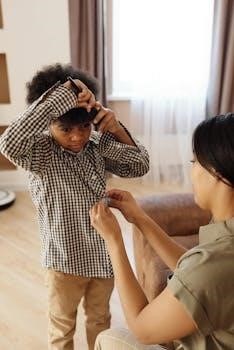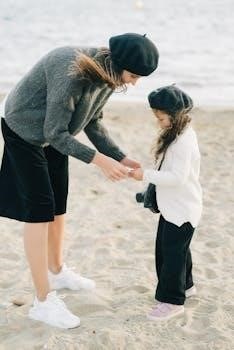
Bringing a dog into your family is exciting! This guide helps kids understand how to care for their furry friends, teaching responsibility and building a lifelong love for animals, ensuring happy and healthy pups.
Why Learning About Dog Care is Important
Learning about dog care is essential for kids, fostering responsibility and empathy. It teaches children the importance of meeting a living being’s needs, from providing food and water to ensuring safety and well-being. This knowledge cultivates crucial life skills, promoting independence and accountability. Understanding dog behavior and body language enhances safety, preventing potential accidents. Caring for a dog also provides opportunities for physical activity, such as walking and playing, promoting a healthy lifestyle. Moreover, it strengthens the bond between children and their canine companions, creating cherished memories and a sense of companionship. Ultimately, learning about dog care makes children better pet owners and compassionate individuals. It allows them to contribute positively to their dog’s happiness and health, making the family-dog dynamic more harmonious. Finally, it’s fun!

Understanding Basic Dog Needs
Dogs, like people, need food, water, and exercise to stay healthy and happy. They also need a safe and comfortable place to live, and lots of love.
Essential Daily Care⁚ Food and Water
Providing your dog with the right food and fresh water is super important for their health. Just like us, dogs need nutritious meals to keep them energized and growing strong. Always make sure their food bowl is filled with the food that is specifically meant for them, avoiding scraps or too many treats, as human food can be harmful. Remember, things like chocolate, grapes, and raisins should be avoided. Fresh, clean water should always be available, and bowls should be washed regularly. By helping with food and water, you are ensuring your dog is healthy and happy! These are very important daily tasks.
The Importance of Exercise and Play
Just like us, dogs need exercise to stay healthy and happy! Playing with your dog is a fun and important part of their daily care. Exercise helps them stay fit, both physically and mentally. Activities like walking, running, and playing fetch are great ways to keep them active. It’s also a fantastic time to bond with your furry friend. Regular play helps dogs release energy and prevents boredom. Make sure they get enough exercise every day, keeping their tails wagging and their minds engaged. This ensures a happy and healthy life for your canine companion, strengthening the bond you share.

Kid-Friendly Ways to Help With Dog Care
Kids can help care for dogs in many fun ways! From assisting with training to gentle petting, there are many age-appropriate tasks to make dogs happy and healthy.
Assisting with Training and Commands
Kids can play a vital role in a dog’s training! Even young children can help by using the dog’s name and encouraging good behavior. As kids get older, they can learn to give simple commands like “sit” and “stay” under adult supervision. Consistent and positive reinforcement is key for successful training. Kids can also participate in fun, interactive training sessions, making it a great way to bond with their furry friend. Remember to keep training sessions short and playful, ensuring the dog doesn’t become frustrated. With patience and practice, kids can help teach their dog new things and strengthen their relationship. Learning together makes training a fun family activity.
Safe Petting and Handling Techniques
Learning how to safely interact with dogs is crucial for kids. Gentle petting is key, avoiding sensitive areas like the eyes, ears, and mouth. Kids should learn to stroke a dog softly rather than grabbing or pulling fur. Always approach a dog calmly and let them come to you. Never chase or corner a dog. Supervise young children closely during interactions. If a dog seems uncomfortable, stop petting and give them space. Teaching kids to recognize a dog’s body language is important for safe handling. By learning these techniques, kids can build positive and trusting relationships with their canine companions. Safe interaction ensures happiness for both kids and dogs.

Age-Appropriate Tasks for Kids
Different ages can handle various dog care tasks. This section outlines suitable chores for toddlers, older children, and teenagers, ensuring everyone can contribute safely and effectively to the dog’s well-being.
Toddlers and Young Children (Ages 2-4)
For toddlers and young children aged 2 to 4, interactions with the family dog should always be supervised and gentle. At this age, the primary focus is on learning safe petting techniques, such as stroking the dog softly, avoiding sensitive areas like the eyes, ears, and tail. It’s important to teach them to not grab or pull at the dog’s fur. They can also begin to learn their dog’s name. Dropping treats on the floor for the dog to pick up is another safe way for them to be involved. Remember, patience and supervision are key to building positive interactions between your child and the dog. Gradually, with guidance, they will develop a love and respect for their furry companion.
Older Children (Ages 5-10)
Children aged 5 to 10 can take on more responsibility in caring for a dog. They can start assisting with brushing, learning how to gently groom the dog while being supervised. They can participate in walking the dog, initially holding an extra loop on the leash alongside an adult. They can learn basic commands like ‘sit’ and ‘stay,’ engaging in supervised training sessions, making it fun and interactive. Playing fetch is an excellent activity for this age group. They can also help with providing fresh water and food under adult supervision, fostering a sense of responsibility. Always ensure these interactions are supervised for the safety of both the child and the dog.
Teenagers and Advanced Care
Teenagers can handle more advanced dog care tasks. They can independently walk the dog, ensuring they pick up after it and dispose of waste responsibly. They can prepare the dog’s meals, understanding portion control and dietary needs. They can also assist with bathing, learning to use dog-specific shampoos and avoiding sensitive areas. Additionally, teenagers can learn to recognize signs of discomfort or illness in the dog, communicating these concerns to adults; They can also take on the responsibility of engaging the dog in more advanced play and training exercises, fostering a deeper bond and ensuring the dog’s mental and physical well-being. They can also start assisting with vet visits and basic first aid under supervision.

Safety and Responsibility
Always supervise interactions between children and dogs, ensuring gentle handling. Understanding dog body language is crucial to prevent accidents. Responsible pet ownership includes providing for all of the dog’s needs.
Supervision and Safe Interactions
Supervising children around dogs is paramount for the safety of both. Young kids might not understand gentle handling, potentially leading to accidental nips or discomfort for the dog. Never leave a toddler or young child unsupervised with a dog, regardless of the dog’s temperament. Teach children how to interact gently, avoiding grabbing or pulling. Always introduce them slowly and in a controlled environment. Some dogs are more tolerant of children than others, so vigilance is key. Supervise all play sessions, and be ready to intervene if either the child or the dog seems stressed. Remember, responsible pet ownership means ensuring safe interactions at all times. Also, always be sure to supervise young children when they are handling or interacting with the family pooch. This will help ensure a happy and safe home for everyone.
Understanding Dog Body Language
Learning to read a dog’s body language is crucial for safe and positive interactions. Dogs communicate through their posture, tail wags, ear positions, and facial expressions. A wagging tail doesn’t always mean happiness; it can also indicate excitement or even agitation. Stiff bodies, tucked tails, or pulled-back ears can signal fear or discomfort. Yawning, lip licking, and whale eye (showing the whites of their eyes) can indicate stress. Teach children to recognize these signs. If a dog is showing signs of discomfort, it’s essential to give it space; Never force interaction with a dog that seems uneasy. Understanding canine communication ensures children can be respectful and safe around dogs, fostering a harmonious relationship.